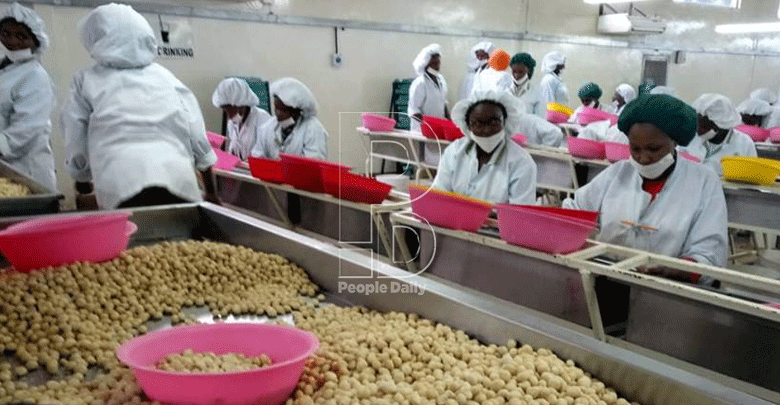Fortifying healthy lifestyles with nutritious food

Dr Moses Mwangi, Chief Executive Officer at Equatorial Nut Processors (ENP)- FBF Division, reveals the work it takes to ensure nutrition is at centre stage of healthy Kenyans.
Milliam Murigi @millymur1
When Equatorial Nut Processors (ENP) decided to introduce a Fortified Blended Flour/Food (FBF) division in their company in 2015, they couldn’t go for any person to head the division.
They wanted someone who had health and nutrition matters at heart. Dr Moses Ndungu Mwangi, a pharmacist, was lucky to get that position.
FBF consist of a granulated mixture of precooked cereal flours supplemented with and fortified with vitamins and minerals.
They are mostly used in humanitarian relief programmes. Fortified blended foods were developed in the 1960s to improve the nutritional status of children suffering from malnutrition.
“For long, as a health practitioner, I had introduced several initiatives to drive nutrition in health.
I believe nutrition should take centre stage in the management of diseases. I believe it is why I was considered among others,” says Mwangi, the Chief Executive Officer at ENP- FBF Division.
ENP is an agro-processing plant based in Maragua town, Muranga County, and has its headquarters in Nairobi.

It is a leader in Macadamia, cashew, and peanut nuts value addition activities.
The FBF division is dedicated to the manufacture of fortified blended flour for high impact nutrition interventions.
“ENP is working with partners in the health industry, national and county governments to address micronutrient malnutrition needs within the region.
As the pioneering CEO, I have been scaling new heights and adding knowledge to the community for better health,” Dr Mwangi says.
He says decades ago infectious diseases were the main health challenge, but now non-communicable diseases have overtaken them. Since food is the major driver of such diseases, we must look at our nutrition if we want to change.
He adds that the increase of malnutrition cases in Kenya and shortage of manufacturers of fortified blended food made the company decide to come up with this division to fill this critical gap.
“Reducing malnutrition requires nutritious food. FBF has several benefits; it is more nutritious and the cost is low as compared to its nutritional value.
It is tasty, flexible in preparation and has short cooking time since they are pre-cooked, it is highly digestible, has extended shelf life, and it is a safe food,” he explains.
According to research by the Kenya National Bureau of Statistics in 2015, out of total under-five populations of seven million, 1.82 million children (26 per cent) were suffering from chronic malnutrition (stunting or low height-for-age).
Compound growth
“The consequences of malnutrition should be a significant concern for policymakers in Kenya. As we get urbanised our nutrition worsens.”
Dr Mwangi has managed to secure the market for the products. Currently, ENP is providing all public hospital with nutritional supplements, have partnered with three county governments to ensure children have access to fortified blended porridge, have partnered with international non-governmental organisations, which are trying to fight malnutrition and plans are underway for the company to partner with the Ministry of Education to address malnutrition issue in slums and arid and semi-arid counties, especially for the pre-primary level of education.
The company is also set to launch yet another processing plant ,which will be processing Ready-to-use therapeutic food (RUTF).
RUFT is high-energy fortified food that is predominantly used in the treatment of Severe Acute Malnutrition (SAM).
A recent study by persistence market research shows that the Sh33.8 billion global ready-to-use therapeutic food is slated to reach over Sh68 billion by the end of 2024.
The market is expected to see exponential growth at a Compound Annual Growth Rate of around 10.5 per cent over a seven-year forecast period, 2017-2024.
“By April, we will be producing ready–to–use therapeutic food to address the problem of SAM condition, which kills at least a million children globally.
Though in Kenya SAM has been going down because of the relative stability the country is enjoying, Horn of Africa continues to lead with SAM cases.” he adds.
Dr Mwangi reveals that demand for FBF and RUTF will triple since there is wider acceptance for highly nutritious blended food by vulnerable groups, schools, and even government.
However, he is quick to note it has not been all rosy for this division, which majorly relies on maize, soybean, and sorghum to make the flour.
They have experienced unsustainable supply of safe raw materials, especially soybean forcing them to import mostly from Malawi and Uganda.
“Soybean is a major component and key raw material for FBFs and yet Kenya is still importing. To ensure this challenge ends, we are contracting soya farmers and in the next three years we will be sourcing our soya locally,” he says.
Before exiting the company next year to vie for the Murang’a gubernatorial position, Dr Mwangi says that he wants to transform soya farming in the country by bringing more farmers onboard.












